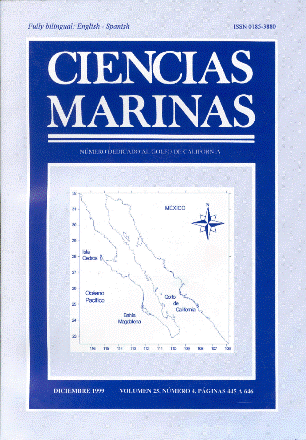The Colorado River Delta: A high primary productivity ecosystem
Main Article Content
Abstract
The construction of major dams in the Colorado River has produced a drastic effect on the amount of fresh water entering the Colorado River Delta. After 1935 there was a dramatic decrease in fresh-water input, causing ecological impacts and a decrease of organisms in the natural habitat. We carried out six spatial samplings during a period of no fresh-water inflow to the delta, in June, August and November 1989, and February, April and June 1990; during each sampling, a 24-hour time series was conducted at one station and seawater samples were taken every two hours. Also, in May 1991 we carried out an eight-day time series, taking samples of seawater at 08:00, 12:00 and 16:00 hours. The objective was to estimate phytoplankton abundance, chlorophyll concentration and primary productivity during a period of no fresh-water input. In the spatial distribution, the chlorophyll a concentrations and phytoplankton abundance were higher on the Baja California side than on the Sonora side, with concentrations of 2.6–18.2 mg m–3 and 1.8–12.7 mg m–3 and of 274 and 166 cells mL–1, respectively. In the time series, the dinoflagellates were more abundant than the diatoms. The primary production showed a tendency to decrease from August 1989 to June 1990, with values of 15.0 to 0.5 mgC m–1. The primary productivity values in the time series presented a tendency to increase during the tide transition, reaching values of 76 mgC m–1. The variations of chlorophyll concentration, phytoplankton abundance and primary productivity were strongly influenced by the effects caused by the tidal currents.
Downloads
Article Details
This is an open access article distributed under a Creative Commons Attribution 4.0 License, which allows you to share and adapt the work, as long as you give appropriate credit to the original author(s) and the source, provide a link to the Creative Commons license, and indicate if changes were made. Figures, tables and other elements in the article are included in the article’s CC BY 4.0 license, unless otherwise indicated. The journal title is protected by copyrights and not subject to this license. Full license deed can be viewed here.

